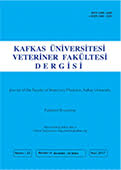
This journal is licensed under a Creative Commons Attribution-NonCommercial 4.0 International License
Kafkas Üniversitesi Veteriner Fakültesi Dergisi
2017 , Vol 23 , Issue 6
Histoanatomical Studies on the Fibrous Tunic of Eye in Dromedary Camel
1Department of Basic Sciences, College of Veterinary Medicine Tabriz Branch, Islamic Azad University, Tabriz, IRAN
DOI :
10.9775/kvfd.2017.17976
This study was conducted to understand the macroscopic and microscopic structures of the fibrous tunic of 20 healthy adult dromedary
camel eyes. First, the fibrous tunic of the eye was anatomically examined in terms of appearance, dimensions, location and structure. Then
prepared histological slides were studied microscopically after staining by H&E, Verhoeff, Trichrome masson"s and P.A.S. The result showed
that in the oval-shaped camel cornea, the internal angle is rounder than the external one. The average cornea length (lateral-medial), width
(dorsal-ventral), and thickness were respectively measured as 2.91±0.05, 2.07±0.04, and 0.12±0.05 cm. The thickest part of sclera is in the
posterior pole of the eyeball. There was not any Bowman"s membrane in camels. Descemet"s membrane includes a rather even, pink, thick
and shapeless membrane. Descemet"s membrane is characterized with a very high positive P.A.S. reaction. Caudal endothelium of cornea did
not show positive P.A.S. reaction and is observed in the form of a thin band attached to descemet"s membrane. In the structure of sclera, the
collagen fibers are remarkably thick, and the longitudinal and transverse cross sections are observed in the form of alternating layers. There
were small elastic fibers in camel sclera. In anatomy, except for some differences, the cornea and sclera of the camel are similar to those of
the other ungulates. Except for a little differences in Bowman"s layer and descemet"s membrane, it is similar to the fibrous tunic of the other
animals.
Keywords :
Dromedary camel, Eye, Fibrous tunic, Histoanatomy










